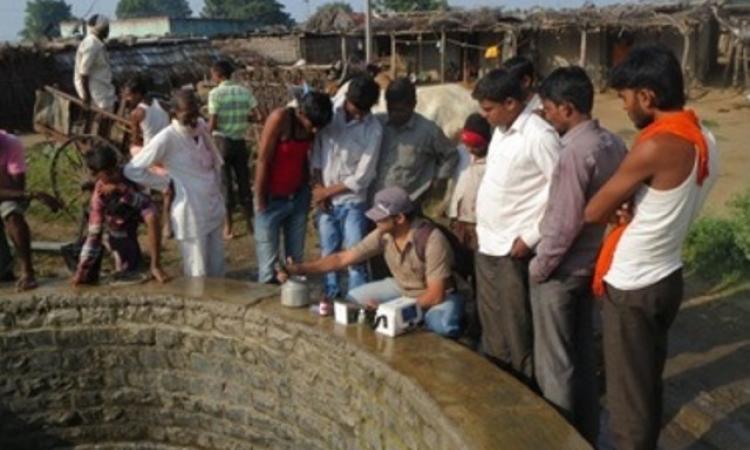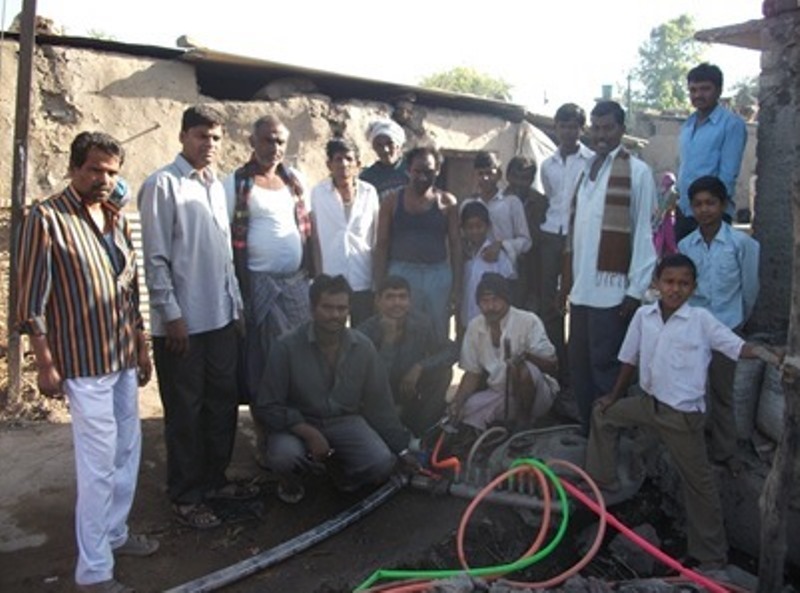
Santosh Gavale, a resident of Manyali village in Umarkhed tehsil of Yavatmal district, is a happy man now. The village, which has faced an increasing water crisis over the years, is now water sufficient because it manages its water resources well and shares it equitably. Santosh managed to do this for his village.
Santosh was part of the Nirman Fellowship, an initiative of Search Foundation in Gadchiroli and Maharashtra Knowledge Corporation Limited (MKCL). Having a rural background, he was always interested in village development programmes focusing on health, education, basic infrastructure, sanitation and agriculture and was also inspired by Gandhiji’s idea of rural India.
Drinking water scarcity in Manyali village and the plight of women
Manyali, part of the Amravati Division of Maharashtra, is located near the Penganga Wildlife Sanctuary. With an annual rainfall of about 600 mm, it is also the district with the highest number of farmer suicides in the state. In the latter years of the first decade of this century, the village experienced severe drinking water scarcity with depleting water resources. Every year, the Gram Panchayat had to intervene and manage the water availability in the village by taking control of wells and restricting excessive withdrawal of water from the wells. Unfortunately, this did not help. It demanded a sustained solution.
Acute water scarcity meant that women in the village had to walk much longer distances during the summer to gather water from the wells in the farms. The children were also employed for this daily chore. It caused a lot of discomfort to women and consumed a lot of their time. Although traditionally the village was dependent on community wells known as ‘aad'’ in the local language, discontinuity in their use had caused deterioration of the water quality.
However, this situation was to change soon.
The community comes together
Santosh had returned from the Nirman programme in 2010 to his village and realised that there was a need to find a solution to the water crisis in the village, a need also acutely felt by the other residents in the village. Some initial community meetings were organised and all agreed and it was decided that there was a need to have a well in the village to suffice their water needs.
In one such meeting, Santosh put up the following calculation in front of the community, “On an average, we spend about 4 hours a day to fetch water for our domestic needs. It means about 120 hours in a month and about 60 days in a year. Instead, if each family contributes about 8 to 10 days of labour for digging up the well, we can have a permanent solution to this problem”. On understanding the situation with such clarity, the community agreed to take up well construction in the village.
The Gram Panchayat, which was initially reluctant, also agreed to it later. The site where the well was to be constructed was encroached upon by a person from the village. When he was asked to give up the land, he refused. The villagers were adamant to have the well constructed at the same site, so they staged a demonstration in front of his house as a result of which he succumbed.
Men and women participate in the construction
After some village meetings, the community agreed to contribute in terms of labour for digging the well. Initially, only women participated in this since they felt the importance of such an initiative. Gradually, families started participating and worked laboriously. Due to these efforts, a 30 foot deep dugwell was constructed in 2011. Santosh crowd-sourced some funds with the help of his Nirman network to undertake some mechanised work of blasting as well as constructing the well wall.
Efforts made at equitable distribution of water
Initial water tests revealed the safe quality of water for drinking and domestic use. The issue of source of water was resolved due to this effort, but the prevailing question was of distribution of water in the village.
The solution came up from an idea proposed by a farmer in one of the Gram Sabha meetings. The farmer suggested that a 3 hp capacity pump could support a sprinkler set of 12 to 15 nozzles. The same logic could be applied to distribute this water through a piped water system. So a cheaper option of having such multiple faucets in different parts of the village was arrived upon.
In order to set up this system of pump and pipes, a voluntary contribution of Rs. 1000 was collected from the families in the village and the system was put in place. A pipe was put up across the village and about 9 valves were fitted. Each valve has about 12 to 15 faucets and the water was supplied through these valves.

Even today, three years down the line, the water is supplied though these 135 faucets in the village, which is then used for drinking, domestic and livestock use. Due to such an interactive and consultative participation, the huge cost of constructing a storage tank -- which was the general practice followed -- was saved.
Establishment of a community managed water supply system
Arun, a landless resident of the village is in-charge of looking after and administering the water supply system. He is entrusted with the job of ensuring water supply to the village. He plans his work according to the electricity schedule in the village. The pattern of water supply changes in different seasons so as to meet the needs throughout the year.
He is given an honorarium of Rs. 3500 per month to manage the system and to tend to repairs and issues. He has also been trained to repair solar equipment and also does that work for all the streetlights in the village that are solar powered. Arun is also part of the Participatory Groundwater Management programme in the village and monitors 15 wells on a monthly basis.
Dr. Abhay Bang, the founder of SEARCH organization in Gadchiroli and who initiated the Nirman programme, was present during the inauguration of the well. For the past three years, this system of water supply has been functioning well. People have a stake in it since they contributed not only monetarily, but also by means of labour. Now each year, every family contributes Rs. 500 towards the operation and maintenance cost of the water supply system. As a result of this, very few people have taken private borewells.
Hand-pumps provided by the government are not used anymore. When the ACWADAM team conducted in-situ water quality tests for all these water sources, the water quality of the community well was good while that of the borewell was very poor. It is only through such a collaborative effort of the villagers, the Nirman Network, the local government officials associated with MGNREGA and other schemes, that the drinking water security for the village has been met through groundwater.
Further efforts at solving the water problem of the Banjara community
It wasn't only their own problems but the people in the village also came together to solve the problems of the Banjara community who stay in a small settlement called tanda about three kilometres away from the village with a population of 1000.
Although the problem of water supply for the village was resolved, that for the tanda was not. The tanda being 3 km away from the village, it was very costly to cover it under the water supply from the same well. The tanda currently had one community drinking water well, but it was not sufficient for year long supply of drinking and domestic water.
Through discussions with the residents, it was decided that a new well would be constructed near the boundary of the village and the forest, and the work would be taken up through MGNREGA. The residents contributed to this initiative as labourers and the new well was taken up. Although the system of piped water supply around the tanda is not yet complete, the residents have made plans for the same.
For the past three years, the government has stopped giving grants to the village to address the drinking water situation since the village has become self-sufficient. This year the total rainfall in the village has been 306 mm, which is almost half the average rainfall in the region. However, residents are confident that they will not face any drinking water scarcity in the village!
Santosh Gavale rightly points out, “As a result of this entire exercise, we all gained the confidence that we should make efforts at resolving our questions and issues on our own instead of depending on an external agency. If we initiate work in the village that truly reflects the crisis and the need of the village, we can definitely succeed in our endeavours!”